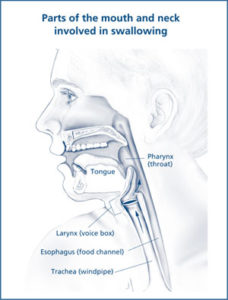Dysphagia means difficulty swallowing food or liquid from mouth to stomach. It can occur at any age, but it is more common in old age. Usually, it is not the cause for concern but it might sometimes associate with the pain resulting impossible in swallowing. This module will help to clarify your understanding of how does dysphagia occur?
If you need more information or you have a question regarding Dysphagia , you can discuss it with our HearingSol healthcare professionals, just give us a call on +91-9327901950. We are always here to help you.
What is dysphagia?
Fast eating or without chewing food may occur occasional difficulty swallowing. Eventually, dysphagia occurs in older adults frequently. The causes of swallowing difficulties can’t be identified hence treatment depends only on the determinant.

Some signs and symptoms of dysphagia may include losing weight, frequent heartburn, drooling, food or stomach acid back up into your throat, gagging or coughing when swallowing, and being unable to swallow, etc. Swallowing is a profound function and several conditions can obstruct with this process. However, dysphagia generally falls for the following reasons:
Esophageal dysphagia –
A sensation of food sticking in the base of the throat or chest after having started to swallow. Some of the causes are:
- Achalasia- When muscles in the wall of the esophagus don’t relax properly or weaken to let food in. It is a condition that gets worse over time.
- Diffuse spasm- Produces multiple high-pressure and affects the involuntary muscles in the walls of the lower esophagus usually after a swallow.
- Esophageal stricture- Tumors or scar tissue (scleroderma) makes esophagus (stricture) narrow that trap large pieces of food.
- Esophageal tumors or ring- When esophageal tumors arising, cannot move all the food towards the stomach. The difficulty tends to upwards.
- Eosinophilic esophagitis- may be related to a food allergy, is created by an overpopulation of cells in the esophagus.
- Radiation therapy- cancer treatment can cause esophagus’s inflammation and scarring.
Oropharyngeal dysphagia-
Generally, People with neurological or nervous system disorders are more liable to experience difficulty swallowing. Causes include:
- A neurological disorder such as muscular dystrophy, Parkinson’s disease, and multiple sclerosis, etc.
- Neurological damage- Like damage from the brain, a stroke, or spinal cord injury can affect.
- Pharyngoesophageal diverticulum- A small sac, just above your esophagus, collects food particles in the throat, often, leads to gurgling sounds, bad breath, and difficulty swallowing.
- Aging- Due to physical aging, tear on the esophagus, and a greater risk of stroke or Parkinson’s disease, older are at higher risk of dysphagia.
Reduce your risk of occasional difficulty swallowing by chewing your food well or eating slowly. Early perception and powerful treatment such as surgery and medication can lower the possibility of developing dysphagia.
Symptoms
- Pain During Swallowing (AudioNew Phage)
- Unable to swallow
- The sensation of food is behind your throat or chest or your bone (sternum)
- Drooling
- Recalling food (regression)
- Irritability
- Food or stomach acids coming back to your throat
- Unexpectedly losing weight
- Coughing or gagging on swallowing
- Due to problems in swallowing, cut food in small pieces or avoid some foods.
Risk factor
Following are the risk factors for dysphagia:-
- Aging:- Due to natural aging and general wear and tear on the esophagus and high risk of certain conditions. Like stroke or Parkinson’s disease, large adults are more prone to difficulty swallowing. However, dysphagia is not considered a normal sign of aging.
- Certain health conditions:- People with some neurological or nervous system disorders are more likely to experience difficulty in swallowing.
Treatment
Your treatment will depend on what is the reason for your dysphagia. Some treatments
- Change the food items you eat. Your doctor may ask you to eat some foods and liquids to make it easier to swallow.
- Endoscopy In some cases, a long, thin radius can be used to remove the object trapped in your esophagus.
- Spread: In this treatment, a device is placed under your esophagus to carefully detail any narrow areas of your esophagus. You may need treatment more than once.
Consideration
Consult your doctor if you regularly have difficulty swallowing, weight loss or vomiting accompanies your dysphagia. If an obstacle interferes with breathing, call for help immediately. If you are not able to swallow because you feel that the food is stuck in your throat or chest, go to the nearest emergency department.
Read More –
